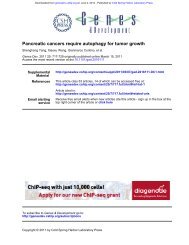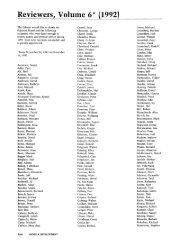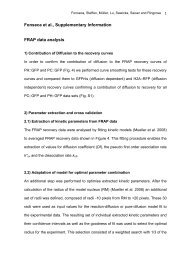I-Rel: a novel rei-related protein that inhibits NF-KB transcriptional ...
I-Rel: a novel rei-related protein that inhibits NF-KB transcriptional ...
I-Rel: a novel rei-related protein that inhibits NF-KB transcriptional ...
Create successful ePaper yourself
Turn your PDF publications into a flip-book with our unique Google optimized e-Paper software.
Downloaded from<br />
genesdev.cshlp.org on December 18, 2012 - Published by Cold Spring Harbor Laboratory Press<br />
were incorporated into a bacterial expression vector (pDS<br />
I-<strong>Rel</strong>A3'). Purification of the truncated I-<strong>Rel</strong> <strong>protein</strong> was<br />
achieved by the addition of 6 histidines at the amino<br />
terminus, which facilitates purification using a nickel<br />
chelate affinity matrix (Gentz et al. 1989). For control<br />
purposes, a similar strategy was used in parallel for purification<br />
of p50 (amino acids 1-377) and p65 (amino acids<br />
1-309), as described previously (Ruben et al. 1992).<br />
High-level expression of each of the <strong>protein</strong>s was obtained<br />
(Fig. 3). Strong association with the <strong>KB</strong> probe was<br />
observed using either purified bacterially expressed p50<br />
or p65 (Fig. 4A). However, no association of the <strong>KB</strong> motif<br />
with I-<strong>Rel</strong>(A3') was observed. To provide for the possibility<br />
<strong>that</strong> the denaturation and rcnaturation involved in<br />
purification may be deleterious to I-Rcl function, crude<br />
bacterial extracts were also used in the binding studies<br />
and provided similar results (Fig. 4B).<br />
One possibility for the lack of binding is <strong>that</strong> I-<strong>Rel</strong><br />
recognizes a DNA motif other than the canonical <strong>KB</strong><br />
consensus sequence. To examine this possibility, an oligonucleotide<br />
degenerate at 18 contiguous nucleotides<br />
was prepared. Incubation of the degenerate oligonucleotide<br />
probe using either purified p50 or p65 or a <strong>protein</strong><br />
obtained directly from sonicated bacterial extracts demonstrated<br />
strong association in the gel-shift assay (Fig. 4).<br />
No association of <strong>KB</strong> DNA or the degenerate probe with<br />
I-<strong>Rel</strong>(A3'), however, was evident (Fig. 4). Taken together,<br />
these findings strongly suggest <strong>that</strong> I-<strong>Rel</strong> does not associate<br />
with DNA and, therefore, clearly differs from other<br />
known <strong>rei</strong>-<strong>related</strong> <strong>protein</strong>s.<br />
Formation of nonfunctional p50/I-<strong>Rel</strong><br />
heteiodimeric complexes<br />
Previous studies have established <strong>that</strong> the association of<br />
Figure 3. Purification of I-<strong>Rel</strong> from bacteria. £. coli expressing<br />
the I-<strong>Rel</strong>(A3'), I-<strong>Rel</strong>(A5'), p50( 1-377), and p65( 1-309) <strong>protein</strong>s<br />
were induced with IPTG during mid-logarithmic growth. The<br />
individual <strong>protein</strong>s were purified using a nickel chelate affinity<br />
matrix (see Materials and methods), analyzed on a 10% PAGE<br />
gel, and visualized by staining with Coomassie blue.<br />
I-<strong>Rel</strong> <strong>inhibits</strong> <strong>NF</strong>-<strong>KB</strong> tiansciiptional activity<br />
<strong>rei</strong>-<strong>related</strong> <strong>protein</strong>s with DNA requires multimer formation<br />
mediated through residues within the rel homology<br />
domain (Ghosh et al. 1990; Kieran et al. 1990; Ruben et<br />
al. 1992). To test whether the inability of I-<strong>Rel</strong> to associate<br />
with DNA might reflect lack of a multimerization<br />
function, the ability of I-<strong>Rel</strong> to associate with p50 and<br />
p65 was examined. Because pure p50 and p65 form stable<br />
homodimers, it was necessary to first denature and renaturc<br />
them with an increasing amount of I-<strong>Rel</strong>. The resulting<br />
complexes were assayed for DNA binding using a<br />
gel mobility-shift assay. Similar experiments performed<br />
in parallel included rcnaturation of p50 with p65 and<br />
rcnaturation of p50 with p65A [p65A is encoded by an<br />
alternatively spliced form of p65 mRNA and is deficient<br />
in multimerization (Ruben et al. 1992)]. As reported earlier<br />
(Ruben et al. 1992), p50 readily formed a heteromeric<br />
complex with p65 but not p65A (Fig. 5A, cf. lanes 9-12<br />
with 13-15). Interestingly, rcnaturation of p50 with increasing<br />
amounts of I-<strong>Rel</strong> resulted in loss of DNA binding<br />
(lanes 1-4), indicative of the formation of an inactive<br />
p50/I-<strong>Rel</strong> heteromeric complex. This effect was specific<br />
for p50 as rcnaturation of p65 in the presence of an increasing<br />
amount of I-<strong>Rel</strong> had no effect on the ability of<br />
p65 to bind the <strong>KB</strong> probe (lanes 5-8). These results indicate<br />
<strong>that</strong> I-<strong>Rel</strong> may associate with p50 and not p65. With<br />
long exposure, a weak but detectable slower migrating<br />
complex was seen upon rcnaturation of p50 with the<br />
highest level of I-<strong>Rel</strong> (lane 4). This may reflect residual<br />
low-affinity binding of the p50/I-<strong>Rel</strong> complex to DNA.<br />
For I-<strong>Rel</strong> to function as an effective suppressor of <strong>NF</strong>-<br />
<strong>KB</strong> activity, it must be capable of competing with p65 for<br />
binding to p50. To examine this possibility, bacterially<br />
produced p65 and p50 were combined at a concentration<br />
<strong>that</strong> promotes heterodimer formation and I-<strong>Rel</strong> was<br />
added at increasing concentrations. The <strong>protein</strong> mixture<br />
was denatured followed by gradual rcnaturation and used<br />
in the gel mobility-shift assay (Fig. 5B). As increasing<br />
levels of I-<strong>Rel</strong> were added, a decrease in p50-p65 complex<br />
formation was observed (lanes 3-6), indicating <strong>that</strong><br />
I-<strong>Rel</strong> can compete with p65 for binding to p50.<br />
As I-<strong>Rel</strong> is unable to bind DNA, it was not possible to<br />
determine the specific activity of the bacterially produced<br />
<strong>protein</strong> prepared by the denaturation-renaturation<br />
process. An alternate approach toward examining the<br />
function of I-<strong>Rel</strong> used I-<strong>Rel</strong> <strong>protein</strong> produced in an in<br />
vitro reticulocyte translation system (Fig. 6). Cotranslation<br />
of the RNA encoding the full-length species of I-<strong>Rel</strong><br />
with RNA encoding p50 resulted in a similar level of<br />
expression for both <strong>protein</strong>s (Fig. 6A). Incubation of the<br />
translation reaction containing p50 alone with the <strong>KB</strong><br />
probe gave the expected size complex in the mobilityshift<br />
assay, whereas no complex was observed with addition<br />
of the translation containing only I-<strong>Rel</strong> (Fig. 6B).<br />
In the binding reaction containing the cotranslation of<br />
p50 and I-<strong>Rel</strong> there was a significant reduction in the<br />
amount of p50 binding to the <strong>KB</strong> probe, in agreement<br />
with results obtained with the bacterially derived <strong>protein</strong>.<br />
Furthermore, inhibition occurred at an apparent excess<br />
of p50 to I-<strong>Rel</strong> (Fig. 6A). In the binding reaction<br />
containing p50 and T<strong>Rel</strong> there was also an increase in<br />
GENES & DEVELOPMENT<br />
749







